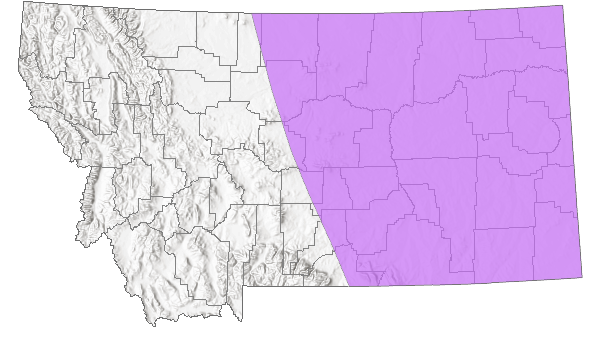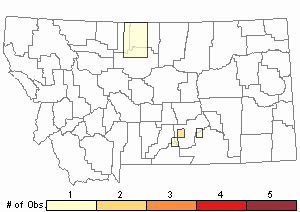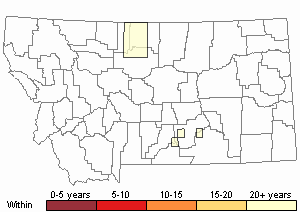View in other NatureServe Network Field Guides
NatureServe
Montana
Utah
Wyoming
Idaho
Wisconsin
British Columbia
South Carolina
Yukon
California
New York
Spotted Bird Grasshopper - Schistocerca lineata
Other Names:
Leather-colored Bird Grasshopper, Lined Bird Grasshopper, Sand Bird Grasshopper, Pland Bird Grasshopper, Birdwing Grasshopper
General Description
The following is taken from Capinera et al. (2004), Scott (2010), Vickery and Kevan (1985). Body color is extremely variable. Base color can be reddish-brown, yellowish-brown, yellowish-green, olive-green, olive-brown, or dark brown. Most individuals have a yellowish dorsal longitudinal stripe that extends from the head to the pronotum and onto the forewings. The stripe can be absent in some individuals, with only a small yellow spot on the pronotum. When disturbed, it flies high and for long distances. Thus, the name "bird grasshopper!
Phenology
This species overwinters in the egg stage. Nymphs emerge in spring. Adults occur from July to mid-October, with peak abundance in August (Vickery and Kevan 1985).
Diagnostic Characteristics
The following comes from Capinera et al. (2004), Scott (2010), Vickery and Kevan (1985). This is a relatively large grasshopper. The body length to end of forewings is 27-37 mm for males and 33-51 mm for females. Hind tibia is black to dark reddish, with long white spines tipped with black. Front and middle femurs of males are inflated. Wings, when fully developed, are as long as the abdomen, and usually surpass its tip. The abdomen usually has a row of dark dots near the rear edge sides of each segment. The eyes possess light longitudinal stripes.
There are many species of Schistocerca in the U.S. In Montana, the Spotted Bird Grasshopper (S. lineata) is the only species with confirmed occurrence reports (Capinera et al. 2004, Scott 2010, Vickery and Kevan 1985).
Species Range
Montana Range
Range Descriptions

 Native
Native
Range Comments
The Spotted Bird Grasshopper has a very extensive range in the U.S. from the east coast to the Great Plains, and southward from the southern grasslands of Saskatchewan and Alberta to northern Mexico. In Montana, it occurs in the eastern two-thirds of the state, with confirmed reports in 8 counties (Bland 2003, Brust 2008, Scott 2010).
Observations in Montana Natural Heritage Program Database
Number of Observations: 6
(Click on the following maps and charts to see full sized version)
Map Help and Descriptions
Relative Density

Recency


 (Observations spanning multiple months or years are excluded from time charts)
(Observations spanning multiple months or years are excluded from time charts)
Habitat
Found in a variety of habitats like dry grasslands, open forest stands, and weedy thickets. Seems to prefer dry areas with sandy soils. Has been collected in some damper habitats like along the margins of small streams and irrigation ditches (Capinera et al. 2004, Scott 2010, Vickery and Kevan 1985).
Food Habits
Wild licorice (
Glycyrrhiza lepidota) is a favorite food plant. Also favors milkvetches, (
Astragalus sp.) and sweet pea, (
Lathyrus sp). Its populations rarely become abundant enough to feed on alfalfa. It feeds little on grasses (Vickery and Kevan 1985).
Reproductive Characteristics
Nymphs appear in spring and adult sexual maturity is reached by early July. A female produces about 200 eggs. Egg masses are laid in the soil, and each pod contains 35-64 eggs (Vickery and Kevan 1985).
Stewardship Responsibility
References
- Literature Cited AboveLegend:
 View Online Publication
View Online Publication Bland, R.G. 2003. The Orthoptera of Michigan—Biology, Keys, and Descriptions of Grasshoppers, Katydids, and Crickets. East Lansing, MI: Michigan State University Extension, Bulletin E-2815. 221 p.
Bland, R.G. 2003. The Orthoptera of Michigan—Biology, Keys, and Descriptions of Grasshoppers, Katydids, and Crickets. East Lansing, MI: Michigan State University Extension, Bulletin E-2815. 221 p. Brust, M.L, W.W. Hoback, and R.J. Wright. 2008. The Grasshoppers of Nebraska. Lincoln, NB: University of Nebraska Extension Service, APHIS.
Brust, M.L, W.W. Hoback, and R.J. Wright. 2008. The Grasshoppers of Nebraska. Lincoln, NB: University of Nebraska Extension Service, APHIS. Capinera, J.L., R.D. Scott, and T.J. Walker. 2004. Field Guide to Grasshoppers, Katydids, and Crickets of the United States. Ithaca, NY. Cornell University Press.
Capinera, J.L., R.D. Scott, and T.J. Walker. 2004. Field Guide to Grasshoppers, Katydids, and Crickets of the United States. Ithaca, NY. Cornell University Press. Scott, R.D. 2010. Montana Grasshoppers, Katydids, and Crickets A Pictorial Field Guide to the Orthoptera. MagpieMTGraphics, Billings, MT.
Scott, R.D. 2010. Montana Grasshoppers, Katydids, and Crickets A Pictorial Field Guide to the Orthoptera. MagpieMTGraphics, Billings, MT. Vickery, V. R. and D. K. M. Kevan. 1985. The grasshopper, crickets, and related insects of Canada and adjacent regions. Biosystematics Research Institute, Ottawa, Ontario. Publication Number 1777. 918 pp.
Vickery, V. R. and D. K. M. Kevan. 1985. The grasshopper, crickets, and related insects of Canada and adjacent regions. Biosystematics Research Institute, Ottawa, Ontario. Publication Number 1777. 918 pp.
- Additional ReferencesLegend:
 View Online Publication
View Online Publication
Do you know of a citation we're missing? Anderson, N.L. 1951. Field studies on the biology of range grasshoppers of southeastern Montana. M.Sc. Thesis. Bozeman, Montana: Montana State University. 96 p.
Anderson, N.L. 1951. Field studies on the biology of range grasshoppers of southeastern Montana. M.Sc. Thesis. Bozeman, Montana: Montana State University. 96 p. Anderson, N.L. 1962. Grasshopper-vegetation relationships on Montana grasslands. Ph.D Dissertation. Bozeman, Montana: Montana State University. 73 p.
Anderson, N.L. 1962. Grasshopper-vegetation relationships on Montana grasslands. Ph.D Dissertation. Bozeman, Montana: Montana State University. 73 p. Capinera, J.L. and T.S. Sechrist. 1982. Grasshoppers of Colorado: Identification, Biology, and Management. Fort Collins, CO: Colorado State University Experiment Station, Bulletin 584S. 161 p.
Capinera, J.L. and T.S. Sechrist. 1982. Grasshoppers of Colorado: Identification, Biology, and Management. Fort Collins, CO: Colorado State University Experiment Station, Bulletin 584S. 161 p. Hebard, M. 1928. The Orthoptera of Montana. Proceedings of the Academy of Natural Sciences of Philadelphia, Vol. 80:211-306.
Hebard, M. 1928. The Orthoptera of Montana. Proceedings of the Academy of Natural Sciences of Philadelphia, Vol. 80:211-306. Hebard, M. 1932. Notes on Montana Orthoptera. Proceedings of the Academy of Natural Sciences of Philadelphia. V. 84. pp 251-257.
Hebard, M. 1932. Notes on Montana Orthoptera. Proceedings of the Academy of Natural Sciences of Philadelphia. V. 84. pp 251-257. Kirk, K. and C.R. Bomar. 2005. Guide to the grasshoppers of Wisconsin. Madison, WI: Wisconsin Department of Natural Resources, Bureau of Integrated Science Services PUB-SS-1008. 154 p.
Kirk, K. and C.R. Bomar. 2005. Guide to the grasshoppers of Wisconsin. Madison, WI: Wisconsin Department of Natural Resources, Bureau of Integrated Science Services PUB-SS-1008. 154 p.
- Web Search Engines for Articles on "Spotted Bird Grasshopper"
- Additional Sources of Information Related to "Insects"





